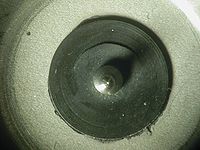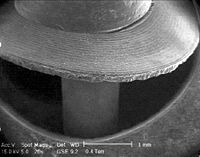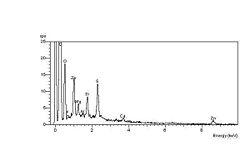
Ozone cracking
Encyclopedia

Ozone
Ozone , or trioxygen, is a triatomic molecule, consisting of three oxygen atoms. It is an allotrope of oxygen that is much less stable than the diatomic allotrope...
attack, and the characteristic form of attack of vulnerable rubbers is known as ozone cracking. The problem was formerly very common, especially in tires, but is now rarely seen in those products owing to preventive measures.
However, it does occur in many other safety-critical items such as fuel line
Fuel line
A fuel line is a hose used to bring fuel from one point in a vehicle to another or from a storage tank to a vehicle. It is commonly made of reinforced rubber to prevent splitting and kinking....
s and rubber seal
Seal (mechanical)
A mechanical seal is a device which helps join systems or mechanisms together by preventing leakage , containing pressure, or excluding contamination...
s, such as gaskets and O-rings, where ozone attack is considered unlikely. Only a trace amount of the gas is needed to initiate cracking, and so these items can also succumb to the problem.
Susceptible elastomers
Tiny traces of ozone in the air will attack double bondDouble bond
A double bond in chemistry is a chemical bond between two chemical elements involving four bonding electrons instead of the usual two. The most common double bond, that between two carbon atoms, can be found in alkenes. Many types of double bonds between two different elements exist, for example in...
s in rubber chains, with natural rubber, polybutadiene
Polybutadiene
Polybutadiene is a synthetic rubber that is a polymer formed from the polymerization process of the monomer 1,3-butadiene.It has a high resistance to wear and is used especially in the manufacture of tires, which consumes about 70% of the production...
, styrene-butadiene
Styrene-butadiene
Styrene-Butadiene or Styrene-Butadiene-Rubber is a synthetic rubber copolymer consisting of styrene and butadiene. It has good abrasion resistance and good aging stability when protected by additives, and is widely used in car tires, where it may be blended with natural rubber...
rubber and nitrile rubber
Nitrile rubber
Nitrile rubber, also known as Buna-N, Perbunan, or NBR, is a synthetic rubber copolymer of acrylonitrile and butadiene. Trade names include Nipol, Krynac and Europrene....
being most sensitive to degradation. Every repeat unit
Repeat unit
An essential concept which defines polymer structure, the repeat unit or repeating unit is a part of a polymer chain whose repetition would produce the complete polymer by linking the repeat units together successively along the chain, like the beads of a necklace.A repeat unit is sometimes called...
in the first three materials has a double bond
Double bond
A double bond in chemistry is a chemical bond between two chemical elements involving four bonding electrons instead of the usual two. The most common double bond, that between two carbon atoms, can be found in alkenes. Many types of double bonds between two different elements exist, for example in...
, so every unit can be degraded by ozone. Nitrile rubber
Nitrile rubber
Nitrile rubber, also known as Buna-N, Perbunan, or NBR, is a synthetic rubber copolymer of acrylonitrile and butadiene. Trade names include Nipol, Krynac and Europrene....
is a copolymer of butadiene and acrylonitrile
Acrylonitrile
Acrylonitrile is the chemical compound with the formula C3H3N. This pungent-smelling colorless liquid often appears yellow due to impurities. It is an important monomer for the manufacture of useful plastics. In terms of its molecular structure, it consists of a vinyl group linked to a nitrile...
units, but the proportion of acrylonitrile is usually lower than butadiene, so attack occurs. Butyl rubber
Butyl rubber
Butyl rubber is a synthetic rubber, a copolymer of isobutylene with isoprene. The abbreviation IIR stands for Isobutylene Isoprene Rubber. Polyisobutylene, also known as "PIB" or polyisobutene, n, is the homopolymer of isobutylene, or 2-methyl-1-propene, on which butyl rubber is based...
is more resistant but still has a small number of double bonds in its chains, so attack is possible. Exposed surfaces are attacked first, the density of cracks varying with ozone gas concentration. The higher the concentration, the greater the number of cracks formed.
Ozone-resistant elastomers include EPDM, fluoroelastomers like Viton
Viton
Viton is a brand of synthetic rubber and fluoropolymer elastomer commonly used in O-rings and other molded or extruded goods. The name is a registered trademark of DuPont Performance Elastomers L.L.C.....
and polychloroprene rubbers like Neoprene
Neoprene
Neoprene or polychloroprene is a family of synthetic rubbers that are produced by polymerization of chloroprene. Neoprene in general has good chemical stability, and maintains flexibility over a wide temperature range...
. Attack is less likely because double bonds form a very small proportion of the chains, and with the latter, the chlorination reduces the electron density in the double bonds, therefore lowering their propensity to react with ozone. Silicone rubber
Silicone rubber
Silicone rubber is an elastomer composed of silicone—itself a polymer—containing silicon together with carbon, hydrogen, and oxygen. Silicone rubbers are widely used in industry, and there are multiple formulations...
, Hypalon
Hypalon
Hypalon is a trademark for chlorosulfonated polyethylene synthetic rubber noted for its resistance to chemicals, temperature extremes, and ultraviolet light. It was a product of DuPont Performance Elastomers, a subsidiary of DuPont....
and polyurethanes are also ozone-resistant.
Form of cracking

Seals are also susceptible to attack, such as diaphragm seal
Diaphragm seal
A diaphragm seal is a flexible membrane that seals and isolates an enclosure. The flexible nature of this seal allows pressure effects to cross the barrier but not the material being contained....
s in air lines. Such seals are often critical for the operation of pneumatic controls, and if a crack penetrates the seal, all functions of the system can be lost. Nitrile rubber
Nitrile rubber
Nitrile rubber, also known as Buna-N, Perbunan, or NBR, is a synthetic rubber copolymer of acrylonitrile and butadiene. Trade names include Nipol, Krynac and Europrene....
seals are commonly used in pneumatic systems because of its oil resistance. However, if ozone
Ozone
Ozone , or trioxygen, is a triatomic molecule, consisting of three oxygen atoms. It is an allotrope of oxygen that is much less stable than the diatomic allotrope...
gas is present, cracking will occur in the seals unless preventative measures are taken.

Stress concentration
A stress concentration is a location in an object where stress is concentrated. An object is strongest when force is evenly distributed over its area, so a reduction in area, e.g. caused by a crack, results in a localized increase in stress...
s, so the tension is at a maximum when the diaphragm of the seal is bent under air pressure.

Viton
Viton is a brand of synthetic rubber and fluoropolymer elastomer commonly used in O-rings and other molded or extruded goods. The name is a registered trademark of DuPont Performance Elastomers L.L.C.....
was also considered as a replacement for the Nitrile rubber
Nitrile rubber
Nitrile rubber, also known as Buna-N, Perbunan, or NBR, is a synthetic rubber copolymer of acrylonitrile and butadiene. Trade names include Nipol, Krynac and Europrene....
. The pictures were taken using ESEM
ESEM
The environmental scanning electron microscope or ESEM is a scanning electron microscope that allows for the option of collecting electron micrographs of specimens that are "wet," uncoated, or both by allowing for a gaseous environment in the specimen chamber...
for maximum resolution.
Ozonolysis
The reaction occurring between double bonds and ozone is known as ozonolysisOzonolysis
Ozonolysis is the cleavage of an alkene or alkyne with ozone to form organic compounds in which the multiple carbon–carbon bond has been replaced by a double bond to oxygen...
when one molecule of the gas reacts with the double bond:

Ozonide
Ozonide is an unstable, reactive polyatomic anion O3−, derived from ozone, or an organic compound similar to organic peroxide formed by a reaction of ozone with an unsaturated compound.-Inorganic ozonides:...
, which then decomposes rapidly so that the double bond is cleaved. This is the critical step in chain breakage when polymers are attacked. The strength of polymers depends on the chain molecular weight or degree of polymerization
Degree of polymerization
The degree of polymerization, or DP, is usually defined as the number of monomeric units in a macromolecule or polymer or oligomer molecule.For a homopolymer, there is only one type of monomeric unit andthe number-average degree of polymerization is given by...
, the higher the chain length, the greater the mechanical strength (such as tensile strength
Tensile strength
Ultimate tensile strength , often shortened to tensile strength or ultimate strength, is the maximum stress that a material can withstand while being stretched or pulled before necking, which is when the specimen's cross-section starts to significantly contract...
). By cleaving the chain, the molecular weight drops rapidly and there comes a point when it has little strength whatsoever, and a crack forms. Further attack occurs in the freshly exposed crack surfaces and the crack grows steadily until it completes a circuit and the product separates or fails. In the case of a seal or a tube, failure occurs when the wall of the device is penetrated.


Ketone
In organic chemistry, a ketone is an organic compound with the structure RCR', where R and R' can be a variety of atoms and groups of atoms. It features a carbonyl group bonded to two other carbon atoms. Many ketones are known and many are of great importance in industry and in biology...
s, which can oxidise further to carboxylic acid
Carboxylic acid
Carboxylic acids are organic acids characterized by the presence of at least one carboxyl group. The general formula of a carboxylic acid is R-COOH, where R is some monovalent functional group...
s. The net result is a high concentration of elemental oxygen on the crack surfaces, which can be detected using Energy-dispersive X-ray spectroscopy
Energy-dispersive X-ray spectroscopy
Energy-dispersive X-ray spectroscopy is an analytical technique used for the elemental analysis or chemical characterization of a sample. It relies on the investigation of an interaction of a some source of X-ray excitation and a sample...
in the environmental SEM, or ESEM
ESEM
The environmental scanning electron microscope or ESEM is a scanning electron microscope that allows for the option of collecting electron micrographs of specimens that are "wet," uncoated, or both by allowing for a gaseous environment in the specimen chamber...
. The spectrum at left shows the high oxygen peak compared with a constant sulfur
Sulfur
Sulfur or sulphur is the chemical element with atomic number 16. In the periodic table it is represented by the symbol S. It is an abundant, multivalent non-metal. Under normal conditions, sulfur atoms form cyclic octatomic molecules with chemical formula S8. Elemental sulfur is a bright yellow...
peak. The spectrum at right shows the unaffected elastomer surface spectrum, with a relatively low oxygen peak compared with the sulfur peak.
Prevention
The problem can be prevented by adding antiozonantAntiozonant
An antiozonant, also known as anti-ozonant, is a chemical compound that prevents or slows down the degradation of material caused by ozone gas in the air...
s to the rubber before vulcanization
Vulcanization
Vulcanization or vulcanisation is a chemical process for converting rubber or related polymers into more durable materials via the addition of sulfur or other equivalent "curatives." These additives modify the polymer by forming crosslinks between individual polymer chains. Vulcanized material is...
. Ozone cracks were commonly seen in automobile tire
Tire
A tire or tyre is a ring-shaped covering that fits around a wheel rim to protect it and enable better vehicle performance by providing a flexible cushion that absorbs shock while keeping the wheel in close contact with the ground...
sidewalls, but are now seen rarely thanks to the use of these additives. A common and low cost antiozonant
Antiozonant
An antiozonant, also known as anti-ozonant, is a chemical compound that prevents or slows down the degradation of material caused by ozone gas in the air...
is a wax which bleeds to the surface and forms a protective layer, but other specialist chemicals are also widely used.
On the other hand, the problem does recur in unprotected products such as rubber tubing and seals, where ozone attack is thought to be impossible. Unfortunately, traces of ozone can turn up in the most unexpected situations. Using ozone-resistant rubbers is another way of inhibiting cracking.
For high value equipment where loss of function can cause serious problems, low cost seals may be replaced at frequent intervals so as to preclude failure.
Ozone gas is produced during electric discharge
Electric discharge
Electric discharge describes any flow of electric charge through a gas, liquid or solid. Electric discharges include:*Electric glow discharge*Electric arc*Electrostatic discharge*Electric discharge in gases*Leader *Partial discharge...
by spark
Electric spark
An electric spark is a type of electrostatic discharge that occurs when an electric field creates an ionized electrically conductive channel in air producing a brief emission of light and sound. A spark is formed when the electric field strength exceeds the dielectric field strength of air...
ing or corona discharge
Corona discharge
In electricity, a corona discharge is an electrical discharge brought on by the ionization of a fluid surrounding a conductor that is electrically energized...
for example. Static electricity
Static electricity
Static electricity refers to the build-up of electric charge on the surface of objects. The static charges remain on an object until they either bleed off to ground or are quickly neutralized by a discharge. Static electricity can be contrasted with current electricity, which can be delivered...
can build up within machines like compressor
Gas compressor
A gas compressor is a mechanical device that increases the pressure of a gas by reducing its volume.Compressors are similar to pumps: both increase the pressure on a fluid and both can transport the fluid through a pipe. As gases are compressible, the compressor also reduces the volume of a gas...
s with moving parts constructed from insulating materials. If those compressors feed pressurised air into a closed pneumatic system, then all seals in the system may be at risk from ozone cracking.
Ozone is also produced by the action of sunlight
Sunlight
Sunlight, in the broad sense, is the total frequency spectrum of electromagnetic radiation given off by the Sun. On Earth, sunlight is filtered through the Earth's atmosphere, and solar radiation is obvious as daylight when the Sun is above the horizon.When the direct solar radiation is not blocked...
on volatile organic liquids or VOLs, such as gasoline vapour present in the air of towns and cities, in a problem known as photochemical smog. The ozone formed can drift many miles before it is destroyed by further reactions.
See also
- Applied spectroscopyApplied spectroscopyApplied spectroscopy is the application of various spectroscopic methods for detection and identification of different elements/compounds in solving problems in the fields of forensics, medicine, oil industry, atmospheric chemistry, pharmacology, etc....
- Brittleness
- Corona dischargeCorona dischargeIn electricity, a corona discharge is an electrical discharge brought on by the ionization of a fluid surrounding a conductor that is electrically energized...
- CorrosionCorrosionCorrosion is the disintegration of an engineered material into its constituent atoms due to chemical reactions with its surroundings. In the most common use of the word, this means electrochemical oxidation of metals in reaction with an oxidant such as oxygen...
- ElastomerElastomerAn elastomer is a polymer with the property of viscoelasticity , generally having notably low Young's modulus and high yield strain compared with other materials. The term, which is derived from elastic polymer, is often used interchangeably with the term rubber, although the latter is preferred...
- Electrostatic dischargeElectrostatic dischargeElectrostatic discharge is a serious issue in solid state electronics, such as integrated circuits. Integrated circuits are made from semiconductor materials such as silicon and insulating materials such as silicon dioxide...
- Forensic chemistryForensic chemistryForensic chemistry is the application of chemistry to law enforcement or the failure of products or processes. Many different analytical methods may be used to reveal what chemical changes occurred during an incident, and so help reconstruct the sequence of events...
- Forensic engineeringForensic engineeringForensic engineering is the investigation of materials, products, structures or components that fail or do not operate or function as intended, causing personal injury or damage to property. The consequences of failure are dealt with by the law of product liability. The field also deals with...
- Forensic materials engineeringForensic materials engineeringA branch of Forensic engineering, the subject focuses on the material evidence from crime or accident scenes, seeking defects in those materials which might explain why an accident occurred, or the source of a specific material to identify a criminal...
- Forensic polymer engineeringForensic polymer engineeringThe study of failure in polymeric products is called forensic polymer engineering. The topic includes the fracture of plastic products, or any other reason why such a product fails in service, or fails to meet its specification...
- OzoneOzoneOzone , or trioxygen, is a triatomic molecule, consisting of three oxygen atoms. It is an allotrope of oxygen that is much less stable than the diatomic allotrope...
- OzonolysisOzonolysisOzonolysis is the cleavage of an alkene or alkyne with ozone to form organic compounds in which the multiple carbon–carbon bond has been replaced by a double bond to oxygen...
- Polymer degradationPolymer degradationPolymer degradation is a change in the properties—tensile strength, colour, shape, etc.—of a polymer or polymer-based product under the influence of one or more environmental factors such as heat, light or chemicals such as acids, alkalis and some salts...
- Stress corrosion crackingStress corrosion crackingStress corrosion cracking is the unexpected sudden failure of normally ductile metals subjected to a tensile stress in a corrosive environment, especially at elevated temperature in the case of metals. SCC is highly chemically specific in that certain alloys are likely to undergo SCC only when...

